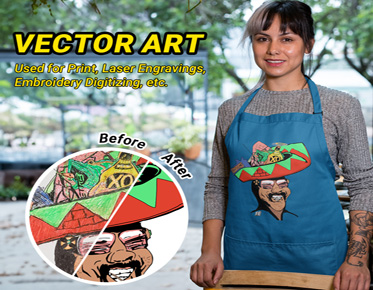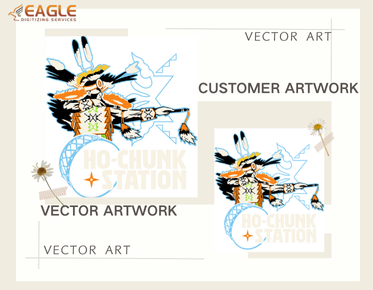The Role of Vector Art in Sustainable Design and Manufacturing
As the world becomes increasingly aware of environmental challenges, the demand for sustainable practices in design has surged. Designers, manufacturers, and consumers alike are seeking solutions that harmonize creativity with ecological responsibility. Enter vector art—a dynamic and flexible medium that is redefining the boundaries of sustainable design. For the premier online vector conversion, feel free to connect with us.
The Connection Between Vector Art and Eco-Friendly Design
How Vector Art Reduces Waste in Design and Production
One of the most significant benefits of vector art is its ability to reduce waste throughout the design and production processes. Traditional design methods often involve numerous drafts, revisions, and physical prototypes, leading to significant material waste. In contrast, vector art enables designers to create digital-first solutions that can be easily modified without starting from scratch. This flexibility not only saves time but also conserves resources.
Creating Digital-First Designs to Minimize Physical Prototypes
By emphasizing digital-first designs, vector art allows for more efficient project workflows. Designers can experiment with various iterations and refine concepts in a virtual environment, dramatically reducing the need for physical prototypes. This shift not only curtails waste but also accelerates the development process, allowing products to reach the market more quickly and sustainably.
Reducing Material Waste Through Vector Art
The Precision of Vector Files: Why It Matters in Sustainable Production
Vector files are defined by precise mathematical formulas, which allows them to achieve remarkable accuracy in representation. This precision is vital in sustainable production, as it minimizes material waste during cutting, printing, and assembly processes. Unlike raster images that can become pixelated when scaled, vector graphics remain sharp and defined, ensuring that every inch of material is utilized effectively.
How Vector Graphics Help Reduce Excessive Material Usage
Utilizing vector graphics in design encourages a more judicious approach to material selection. Designers can create intricate patterns and layouts that maximize material efficiency, allowing for less waste during production. Whether it's fabric, paper, or other substrates, the ability to adapt designs based on available resources ensures that sustainability is prioritized at every step.
The Reusability of Vector Art for Green Design
Repurposing Vector Graphics for Different Projects
Vector graphics lend themselves to reusability, making them a valuable asset in sustainable design. Designers can easily adapt existing vector art for new projects, thus conserving resources and reducing the need for new designs. This approach fosters creativity while minimizing the ecological footprint associated with producing original artwork.
Creating Timeless Designs with Minimal Resources
The nature of vector art allows for the creation of timeless designs that can be repurposed across different applications. By emphasizing versatility and longevity, designers can avoid the trend-driven pitfalls that often lead to wasteful production cycles. As a result, vector art cultivates a sustainable mindset that prioritizes quality over quantity.
Vector Art in Sustainable Packaging Design
How Vectors Can Optimize Packaging to Reduce Material Usage
In the realm of sustainable packaging, vector art plays a pivotal role. By utilizing vector graphics, designers can create packaging solutions that maximize material efficiency while maintaining aesthetic appeal. The precision of vector designs ensures that every aspect of the packaging serves a purpose, reducing excess material and waste.
The Role of Vector-Based Graphics in Recyclable Packaging
Recyclable packaging is essential for sustainable consumer goods. Vector art contributes to this by allowing designers to craft packaging that is not only functional but also easy to recycle. Clear labeling and thoughtful design can promote proper recycling practices, ensuring that materials are reused rather than discarded.
The Impact of Vector Art on Digital Design and E-Commerce
Reducing the Carbon Footprint of Digital-Only Design Projects
Digital design projects inherently have a lower carbon footprint compared to traditional print projects. By using vector art, designers can create digital assets that require minimal physical resources, contributing to a more sustainable design ecosystem. This transition to digital-only solutions is essential for reducing overall environmental impact.
Vector Art’s Contribution to Paperless Marketing and Branding
In the world of marketing, vector graphics allow for the creation of visually striking digital campaigns that require no physical materials. This paperless approach not only conserves resources but also aligns with modern consumer preferences for eco-friendly brands. Embracing vector art for branding and marketing initiatives can significantly enhance a company’s sustainability profile.
Energy-Efficient Design Processes with Vector Art
How Digital Vector Design Uses Fewer Resources Than Traditional Methods
Digital vector design processes consume fewer resources than traditional methods, which often involve labor-intensive practices. By relying on software tools and vector graphics, designers can streamline workflows, minimizing energy consumption and material waste. This efficiency not only benefits the environment but also enhances productivity.
Reducing Production Time and Energy with Vector-Based Processes
The speed at which vector designs can be produced leads to reduced production times and lower energy consumption. Efficient design processes mean quicker turnaround times, allowing businesses to meet consumer demands while maintaining sustainability standards. This energy efficiency is a cornerstone of eco-friendly practices in modern design.
Eco-Friendly Printing and Manufacturing with Vector Art
How Vector Graphics Lead to Efficient, Waste-Reducing Printing
When it comes to printing, vector graphics provide a clear advantage. They produce crisp, high-quality images without the risk of pixelation, ensuring that every print is perfect. This efficiency translates to less paper waste and a more sustainable printing process.
The Role of Vector Files in Low-Impact Manufacturing Techniques
Vector files can seamlessly integrate with various low-impact manufacturing techniques, including digital printing and laser cutting. These methods reduce waste and energy consumption while allowing for intricate designs that traditional techniques may struggle to replicate. The alignment of vector art with eco-friendly manufacturing practices promotes a more sustainable production landscape.
Using Vector Art for Precision in Sustainable Fabrication
Vector Art in 3D Printing and Laser Cutting: Precision with Minimal Waste
In the realm of fabrication, vector art excels in precision. It is the backbone of technologies like 3D printing and laser cutting, which are known for their accuracy and minimal waste production. This precision ensures that every piece is created to exact specifications, reducing excess material usage and enhancing sustainability.
How Vector-Based Designs Contribute to Green Manufacturing Methods
Vector-based designs support green manufacturing methods by streamlining production processes and enhancing efficiency. These designs enable manufacturers to create components that fit together perfectly, minimizing the need for adjustments and reducing waste in the assembly phase.
The Role of Vector Art in Sustainable Fashion Design
Optimizing Fabric Usage with Vector Patterns and Layouts
Fashion designers can leverage vector art to optimize fabric usage through efficient patterns and layouts. By utilizing vector graphics, designers can create intricate designs that maximize fabric yield, reducing waste and promoting sustainability in the fashion industry.
How Vector Graphics are Helping Designers Create Zero-Waste Fashion
The zero-waste fashion movement seeks to eliminate textile waste, and vector art plays a crucial role in achieving this goal. Designers can use vector patterns to create garments that utilize every inch of fabric, resulting in innovative designs without the excess waste commonly associated with traditional methods.
Sustainable Product Design with Vector Art
How Vector Files are Used in Designing Eco-Friendly Consumer Goods
Vector files are instrumental in designing eco-friendly consumer goods. Their scalability and precision allow for the creation of products that are not only visually appealing but also environmentally responsible. By prioritizing sustainable materials and practices in conjunction with vector design, businesses can cultivate a greener product line.
Prototyping with Minimal Resources Thanks to Vector-Based Designs
Prototyping often consumes valuable resources, but vector-based designs can mitigate this impact. Designers can create digital prototypes that accurately represent the final product without wasting materials. This approach not only conserves resources but also accelerates the development process, making it easier to bring sustainable products to market.
Vector Art and Circular Design Principles
Supporting Circular Economy Models with Reusable Vector Assets
The concept of a circular economy emphasizes the importance of reusability and sustainability. Vector art aligns seamlessly with these principles by providing assets that can be repurposed for various projects. This adaptability fosters a more sustainable approach to design and production, reducing waste in the long run.
Designing Products with End-of-Life in Mind Using Vector Graphics
Vector graphics encourage designers to think about the entire lifecycle of a product. By considering end-of-life scenarios during the design process, creators can develop products that are easier to recycle or repurpose, supporting a more sustainable future.
The Benefits of Vector Art for Sustainable Architecture
How Vector-Based Drawings Aid in Green Building Projects
In architecture, vector-based drawings facilitate the planning and execution of green building projects. They allow for precise measurements and details, enabling architects to create structures that maximize energy efficiency and sustainability.
Using Vectors to Create Energy-Efficient Building Plans
Vector graphics contribute to energy-efficient building plans by allowing architects to design layouts that optimize natural light, airflow, and insulation. These considerations reduce energy consumption, leading to more sustainable structures.
Vector Art in Sustainable Industrial Design
Streamlining Industrial Production with Vector Precision
In industrial design, vector artwork enhances production efficiency by providing precise specifications. This precision streamlines manufacturing processes, reducing errors and minimizing material overuse.
Reducing Errors and Material Overuse Through Vector-Based Prototyping
Vector-based prototyping reduces the likelihood of errors during production, resulting in fewer wasted materials. By leveraging vector art, industrial designers can create accurate models that ensure resources are utilized effectively, fostering a more sustainable approach.
Vector Art in Digital-First Design Strategies
How Vector Art Supports the Growing Trend of Digital-Only Products
As the demand for digital-only products grows, vector art becomes an invaluable tool for designers. Its adaptability and precision make it ideal for creating digital assets that resonate with modern consumers while minimizing environmental impact.
Reducing the Need for Physical Prototypes with Vector Simulations
Vector art allows designers to simulate physical prototypes digitally, which drastically reduces the need for tangible models. This shift not only saves materials but also expedites the design process, facilitating quicker turnarounds on sustainable products.
Challenges of Using Vector Art in Sustainable Design
Overcoming the Limitations of Vector Art in Complex, Organic Designs
While vector art offers numerous benefits, it does have limitations, especially when it comes to complex, organic designs. However, designers can overcome these challenges by blending vector art with other mediums to create unique and sustainable solutions.
Balancing Vector Graphics with Sustainable Materials and Practices
To maximize the sustainability benefits of vector art, designers must balance their use of digital graphics with sustainable materials and practices. This holistic approach ensures that the environmental impact of every project is minimized, fostering a more sustainable design landscape. Should this post have fanned the flames of your interest in vector logo conversion and you desire to delve deeper, don't hesitate to communicate with us.
Vector art is not just a tool; it is an essential asset in the pursuit of sustainable design, manufacturing, and production. Its ability to reduce waste, enhance efficiency, and promote eco-friendly practices makes it a cornerstone of modern design philosophy. By maximizing the environmental benefits of vector graphics, designers can forge a path toward a more sustainable future, ensuring that creativity and ecological responsibility go hand in hand.



.png)